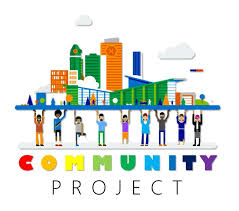
The Power of Community Projects
Community projects play a vital role in bringing people together, improving neighborhoods, and creating positive change. These projects are collaborative efforts that aim to address specific needs or enhance the quality of life for residents in a particular area. Whether it’s beautifying a park, organizing a food drive, or building a community garden, these initiatives have the power to strengthen bonds and make a lasting impact.
One of the key benefits of community projects is that they foster a sense of unity among residents. By working together towards a common goal, individuals from diverse backgrounds come together to create something meaningful for their community. This shared experience builds relationships, promotes understanding, and creates a strong sense of belonging.
Furthermore, community projects have the potential to transform neighborhoods and improve quality of life. For example, revitalizing public spaces can create safe and inviting environments for residents to gather and enjoy recreational activities. Community gardens not only beautify vacant lots but also provide fresh produce for local residents and promote sustainable living practices.
Another important aspect of community projects is their ability to empower individuals and cultivate leadership skills. Through participation in these initiatives, volunteers develop teamwork, communication, and problem-solving abilities. They also gain a sense of accomplishment and pride in contributing to the betterment of their community.
In conclusion, community projects are powerful vehicles for positive change at the local level. By bringing people together, improving neighborhoods, and fostering personal growth, these initiatives have far-reaching benefits that extend beyond their immediate impact. Get involved in a community project today and be part of something truly meaningful!
6 Essential Tips for Successful Community Projects
- Involve the community members in the project planning process.
- Communicate regularly and effectively with all stakeholders.
- Set clear goals and objectives for the project.
- Ensure transparency in decision-making and resource allocation.
- Encourage collaboration and teamwork among participants.
- Celebrate achievements and recognize contributions to maintain motivation.
Involve the community members in the project planning process.
Involving community members in the project planning process is essential for the success and sustainability of community projects. By engaging residents from the outset, project organizers can gain valuable insights into the specific needs and priorities of the community. This inclusive approach not only ensures that the project is tailored to address relevant issues but also fosters a sense of ownership and pride among participants. When community members are actively involved in planning, decision-making, and implementation, they are more likely to be invested in the project’s success and contribute their time, skills, and resources towards achieving common goals.
Communicate regularly and effectively with all stakeholders.
Regular and effective communication with all stakeholders is crucial for the success of community projects. Keeping everyone informed and engaged ensures that goals are clear, expectations are managed, and progress is transparent. By maintaining open lines of communication, project leaders can gather feedback, address concerns promptly, and foster a sense of collaboration among all participants. This proactive approach helps build trust, promotes accountability, and ultimately leads to a more cohesive and impactful community project.
Set clear goals and objectives for the project.
Setting clear goals and objectives for a community project is essential for its success. By defining specific outcomes and milestones, project organizers can provide direction, focus, and motivation for participants. Clear goals help ensure that everyone involved understands the purpose of the project and what needs to be achieved. They also serve as a measuring stick to track progress and evaluate the impact of the project. With well-defined goals and objectives in place, community projects are more likely to be effective, efficient, and meaningful in creating positive change within the community.
Ensure transparency in decision-making and resource allocation.
Ensuring transparency in decision-making and resource allocation is crucial for the success and credibility of community projects. By openly communicating how decisions are made and how resources are allocated, project organizers build trust among participants and stakeholders. Transparency promotes accountability, fairness, and inclusivity, allowing everyone involved to understand the rationale behind choices and feel confident in the project’s direction. It also helps prevent misunderstandings or conflicts by providing clarity on how decisions are reached and resources are distributed, fostering a collaborative and harmonious environment for all involved in the community project.
Encourage collaboration and teamwork among participants.
Encouraging collaboration and teamwork among participants is a crucial tip for successful community projects. By fostering a sense of unity and shared responsibility, participants can leverage their diverse skills and perspectives to achieve common goals more effectively. Collaboration promotes creativity, problem-solving, and mutual support, leading to innovative solutions and a stronger sense of community ownership. When individuals work together towards a shared vision, they not only enhance the project’s impact but also build lasting relationships and a sense of camaraderie that enriches the overall experience.
Celebrate achievements and recognize contributions to maintain motivation.
Celebrating achievements and recognizing contributions are essential practices in community projects to sustain motivation and foster a sense of accomplishment among participants. By acknowledging the hard work and dedication of individuals involved in the project, it not only boosts morale but also reinforces a culture of appreciation and support within the community. Recognizing contributions serves as a powerful motivator for continued engagement and encourages others to actively participate, ultimately leading to the success and sustainability of the project.
